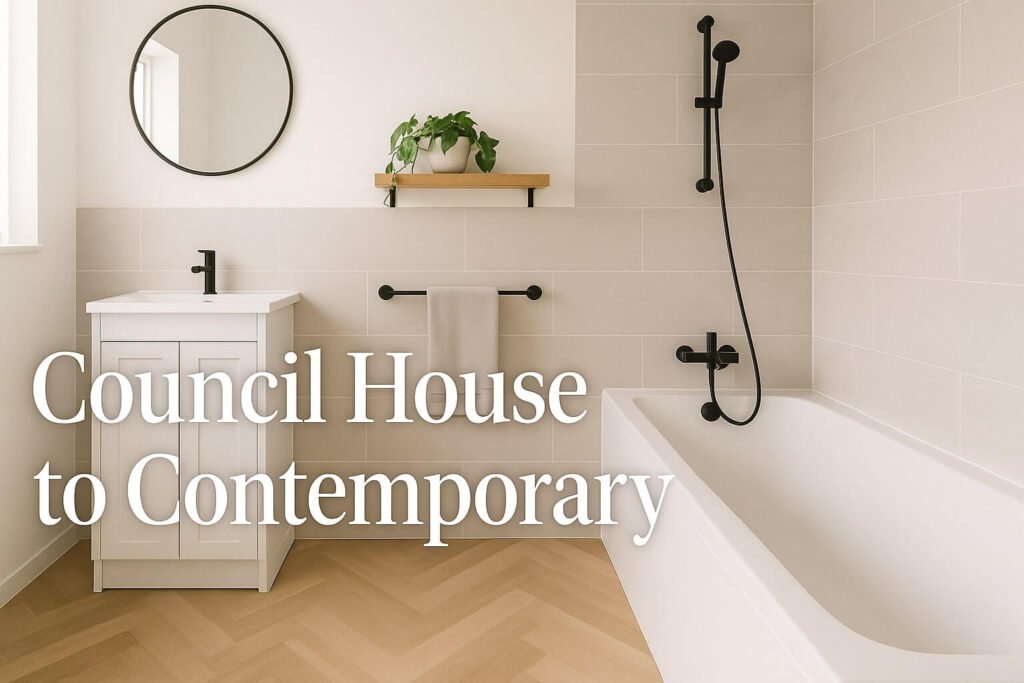Imagine standing in your tired old bathroom. You know the one—square white tiles that have yellowed over the years, plastic panels curling at the corners, a loo that flushes like it’s got stage fright, and lighting that could pass for an interrogation room. It’s the kind of bathroom that came with your council house, and somehow, 20 years slipped by while it stayed exactly the same.
But here’s the twist: you don’t need a high-end showroom or a four-figure contractor invoice to turn that space into something clean, fresh, and genuinely lovely to live in. With smart sourcing, landlord-friendly materials, and a solid weekend’s worth of effort, you can give your bathroom a contemporary upgrade—without blowing the budget or breaking any council rules.
Let’s break it down.
Why So Many Council House Bathrooms Look the Same (and How to Break the Cycle)
Many UK council house bathrooms haven’t changed much since the ’80s or ’90s. That’s not just a design time warp, it’s a practical problem. The layout wasn’t built for modern extractor fans. The grout’s turned grey. That basic acrylic tub has seen better decades. And energy-wise? You might as well be heating the outdoors.
But here’s the good news: the bones are often solid. A council-built property may lack the glamour of a glossy new-build, but it makes up for it in straight lines, sturdy plumbing, and a layout that (with a little love) can still sing.
What’s a Realistic Budget for a Bathroom Refresh?
Let’s say you’re not gutting everything. You’re working smart, not lavish. A basic suite bundle (toilet, basin, 170 cm bath) runs £275–£450 at the likes of Wickes or B&Q. A decent 5 m² vinyl floor will set you back £60–£100. Tile paint or stick-on panels? Another £85-£140 depending on your splash zone.
Even with a plumber’s help for the fiddly stuff (let’s say £400–£800), many council house tenants complete a solid refresh for under £2,000, often much less if you roll up your sleeves and get a bit DIY-happy.
Here’s what smart spenders do:
- Keep the bath if it’s not cracked
- Paint tiles instead of retiling
- Use stick-on vinyl or cushioned sheet flooring
- Source taps and fixtures from salvage yards
- Call in professionals only for electrical or plumbing changes
In short: you don’t need to go luxe. You need to go clever.
Know Your Rights: What Council Tenants Can (and Can’t) Do
If you’re a secure tenant, you can make home improvements, including a new bathroom. But you’ll need to ask first. Councils like Leeds or Birmingham typically approve non-structural changes like sanitaryware swaps or wall panels within 3–4 weeks.
What to include when requesting permission:
- A rough sketch of your proposed layout
- Links to products (especially anything electric or gas)
- Quotes or contractor details if you’re hiring help
Pro tip: keep a digital folder with everything your housing officer might ask. The smoother your pitch, the faster the ‘yes’.
Materials That Save Money Without Looking It
This is where the magic happens, making a council house bathroom feel boutique without the boutique price tag.
1. Tile Paint: Retro Be Gone
Today’s tile paints like Zinsser AllCoat cling like nothing else. One £25 tin can handle 6 m², instantly covering beige, pink, or even faded green ceramic tiles. Add a new sealant line, and your old walls are reborn.
2. Peel-and-Stick Panels: Your New Best Friend
These stick-on panels come in subway, marble, or herringbone styles. They need no grout, trim with scissors, and are perfect behind sinks or over old splashbacks. No tile cutter needed—just a steady hand and some patience.
3. Cushioned Vinyl: Soft on the Feet, Easy on the Budget
Sheet vinyl flooring starts around £12 per m². It looks like wood, tile, or even terrazzo, but installs in under an hour. No messy adhesives or long dry times, just roll it out and trim. Plus, it’s lightweight, so it’s ideal for first-floor flats.
Salvage Yards: Goldmines in Disguise
Think a reclaimed roll-top bath is out of reach? Not so. Places like English Salvage or Sanitary Salvage sell working, beautiful cast-iron baths for £350–£500. You’ll also find retro sinks, taps, even coloured toilets if you want to lean into a bold palette.
And then there’s Freegle, Gumtree, and Salvo. If you’re patient, you might score a solid wood bath panel or a brand-new basin someone never installed. One Homecraft reader turned an entire bathroom around using just £400 worth of salvage, and it looked like a feature in Livingetc.
What You Can DIY (and What You Shouldn’t)
DIY wins:
- Painting tiles or walls
- Fitting peel-and-stick panels
- Replacing toilet seats, shower rails, or mirrors
- Resealing around the bath
- Laying sheet vinyl
Call in the pros for:
- Moving pipes or waste stacks
- Electrical work (especially lighting or extractor fans)
- Fitting baths, toilets, or sinks unless you’ve got plumbing skills
Remember, no one gets points for a botched waste pipe. Know your limits and spend the saved labour budget on better taps or lights.
Styling Tricks to Stretch Small Spaces
Even a narrow council house bathroom can look chic with the right details.
- Stick with three finishes max. White, black, and woodgrain is a classic trio.
- Install floating shelves. Sanded scaffold boards (around £5–£10 each) make gorgeous open shelving.
- Use a large mirror. It’ll reflect light and double the room visually.
- Layer your lighting. A £15 mirror clip light makes a huge impact paired with an LED ceiling panel.
- Slim down the furniture. Cloakroom-size vanity units (from £79) keep things neat without swallowing the room.
Grants You Might Not Know About
If someone in your household has a disability, the Disabled Facilities Grant (DFG) might cover parts of your bathroom revamp. Think: comfort-height toilets, lever taps, walk-in showers. It’s not only for owner-occupiers—council tenants can apply too, with an occupational therapist’s recommendation.
You can even combine a DFG-covered install with your own style upgrades, creating both accessibility and ambiance.


